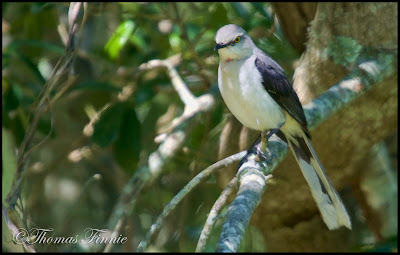A cool-looking Chuck-Will's-Widow was perched on a limb not far off one of the trails.
Left-Click on Images to Enlarge
Have you ever seen two Chuck-Will's-Widows sitting together on the same log? These two guys were statuesque in the shade making it easy to miss while walking the trails. A special thanks to Robby Bacon for pointing these out.
The Grackles guys were strutting their stuff trying to impress the ladies.
Finally, the long-awaited Tropical Mockingbird with its l-o-n-g tail flew up and landed in a tree nearby. It was weird seeing a Mockingbird minus its white wing bars.
What do you think about the white on the underside of its tail feathers? The red on its throat was puzzling.
A good look at its dark wings and white bands on the end of its tail feathers.
The Tropical Mockingbird stretched revealing its dark wings and tail feathers with white bands at the tips.
How do you suppose this guy got here and how will he know where home is in order to return?
During the course of the day the Tropical Mockingbird was flying back and forth to a Live Oak Tree where a Northern Mockingbird had a nest. I'm not certain of his involvement but it does seem suspicious.
Much discussion has been generated regarding the origin of the Tropical Mockingbird as it relates to feather wear. Below are magnifications of its wing feathers and its tail feathers. What are the similarities and differences between birds in the wild vs caged/captive birds as related to feather wear? It will be interesting to hear the committee's verdict and succeeding explanation of how they determined the origin of the Tropical Mockingbird.
Left-Click on Images to Enlarge
Left-Click on the Image. Check out the wing wear and tail feather wear. It appears there is wear on all of its tail feathers but only minimal wear to the 7th, 8th and 9th primaries from the tip of his/her wing. Would this pattern of wear be more typical for a caged bird or would this pattern of wear be more typical for a wild bird?

















